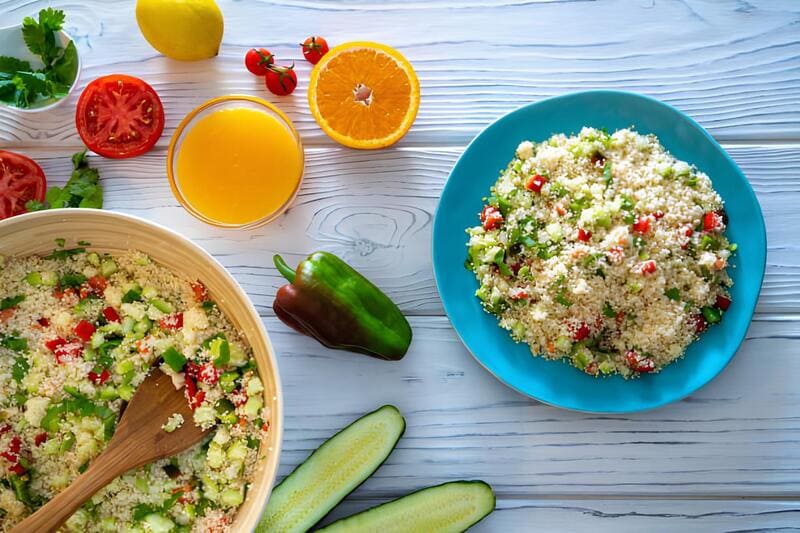
Tabouli is a refreshing and nutritious Middle Eastern salad with deep roots in Lebanese and Arabic cooking traditions. While traditionally prepared with bulgur wheat, this variant uses whole wheat couscous, making it even simpler to prepare. Packed with fresh vegetables and herbs, this dish offers a delightful blend of flavors that tantalize the palette.
Although often associated with Lebanese cuisine, tabouli has spread throughout the Middle East and North Africa, finding a place on the tables of Egyptian, Moroccan, and Turkish homes. It’s a low-calorie dish rich in vitamins and antioxidants, providing numerous health benefits while being incredibly easy to make. Perfect for a light lunch or as part of a larger feast, tabouli truly showcases the vibrancy of Middle Eastern culinary traditions.
Ingredients
- 1 cup whole wheat couscous
- 1 cup boiling water
- 1-2 tsp ghee
- 2 tomatoes, diced
- 1 cucumber, diced
- 1 red onion, diced
- 1 red bell pepper, diced
- 1 yellow bell pepper, diced
- 1 orange bell pepper, diced
- 4 radishes, sliced
- 1 bunch parsley, chopped
- 1 bunch cilantro, chopped
- 4 tbsp olive oil
- Juice of 1 lemon
- Salt to taste
Preparation
- Boil 1 cup of water and add 1-2 teaspoons of ghee.
- Pour the boiling water over 1 cup of whole wheat couscous in a bowl.
- Stir the mixture and cover it, letting it sit for 5 minutes.
- In a large bowl, combine diced tomatoes, cucumber, red onion, bell peppers, and sliced radishes.
- Add the chopped parsley and cilantro to the vegetable mixture.
- Fluff the couscous with a fork and add it to the bowl of vegetables and herbs.
- In a small bowl, whisk together 4 tablespoons of olive oil, the juice of 1 lemon, and salt to taste.
- Pour the dressing over the couscous and vegetable mix, tossing gently to combine fully.
- Serve the tabouli on a platter or wrapped in lettuce leaves for a refreshing, crunchy bite.
Did you know?
Tabouli, also spelled tabouleh or tabbouleh, is more than just a salad. This traditional dish has its origins in the mountains of Lebanon and Syria, dating back thousands of years. It was initially a part of the mezze, a selection of small dishes served to start a meal. In Egypt, tabouli is appreciated for its refreshing qualities, especially during the hot summer months.
Interestingly, couscous comes from the Berber word “seksu,” meaning well-rolled or well-formed, reflecting the way these tiny pasta pieces are crafted. Couscous tabouli is particularly appreciated for its quick preparation time compared to bulgur wheat, making it a popular choice in modern kitchens. The dish is not only a flavorful delight but also a nutritional powerhouse, packed with Vitamin C from bell peppers, antioxidants from cilantro, and essential minerals from parsley.
Beyond its delicious taste and health benefits, tabouli also symbolizes community and tradition. In many Middle Eastern cultures, the process of making tabouli is a communal activity, bringing families and neighbors together. Whether you’re enjoying Moroccan variations or sticking with the Lebanese authentic recipe, this dish continues to be a beloved staple across the Arabic-speaking world and beyond.
